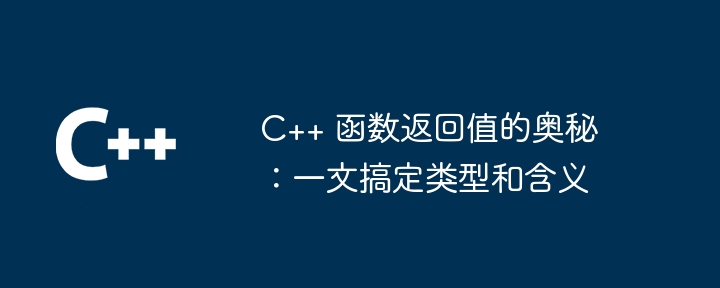Home >Backend Development >C++ >The secret of C++ function return value: get the type and meaning in one article
The secret of C++ function return value: get the type and meaning in one article
- 王林Original
- 2024-05-03 08:09:02380browse
C Function return value types can be divided into void, basic types, composite types and pointer types, and their meanings include success/failure flags, results and object references. Practical examples show how functions returning basic types, composite types, and pointer types work.

The secret of C function return value: type and meaning in one article
Introduction
In C, Function return value is an important concept, which determines the execution flow of the program after calling the function. This article will delve into the types and meanings of C function return values, and help you thoroughly understand this concept through practical cases.
Function return value type
The function return value type refers to the data type of the value returned after the function is called. In C, function return value types can be the following:
- void: Indicates that the function does not return any value.
- Basic types (such as int, double, char) : Indicates that the function returns a single value of the specified type.
- Composite type (such as structure, class): Indicates that the function returns an object reference of the specified type.
- Pointer type: Indicates that the function returns a pointer to the specified type of data.
Function return value meaning
In addition to the type, the function return value also has the following meaning:
-
Success/ Failure flag: Some functions use return values to indicate whether the call was successful. For example, the
fopen()function returns a file pointer, which is a non-null pointer if the file is opened successfully; otherwise, it isNULL. -
Result: The result returned by the function can be a calculated value, a Boolean value, or data extracted from other data structures. For example, the
sqrt()function returns a floating point number representing the square root of its input value. - Object reference: For functions that return composite types or pointer types, the return value is a reference to the object. Using this reference, you can access and modify the object.
Practical cases
In order to better understand the function return value, let us look at a few practical cases:
Example 1: Return basic type
int max(int a, int b) {
return a > b ? a : b;
}This function returns the larger value of a and b.
Example 2: Returning a composite type
struct Point {
int x, y;
};
Point createPoint(int x, int y) {
return {x, y}; // 初始化结构并返回
}This function creates a Point object and returns a reference to it.
Example 3: Return pointer type
int* findMax(int* arr, int n) {
int* maxPtr = arr; // 指针指向数组第一个元素
for (int i = 1; i < n; i++) {
if (arr[i] > *maxPtr) {
maxPtr = &arr[i]; // 指针更新为指向最大值的元素
}
}
return maxPtr;
}This function returns a pointer to the maximum value in the array.
Conclusion
Through the discussion in this article, you should have fully understood the type and meaning of the C function return value. With the help of practical cases, you can also easily master the application of function return values. Remember, function return values are a crucial concept in C that enhance program flexibility and make your code more readable.
The above is the detailed content of The secret of C++ function return value: get the type and meaning in one article. For more information, please follow other related articles on the PHP Chinese website!

